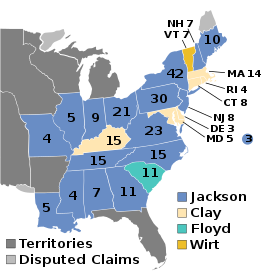Presidential election in the United States 1832
| ‹ 1828 • |
|||||||||||
| 12th presidential election | |||||||||||
| November 2 - December 5, 1832 | |||||||||||
|
|
|||||||||||
| Democratic Party | |||||||||||
| Andrew Jackson / Martin Van Buren | |||||||||||
| electors | 219 | ||||||||||
| be right | 701.780 | ||||||||||
|
|
54.7% | ||||||||||
| National Republican Party | |||||||||||
| Henry Clay / John Sergeant | |||||||||||
| electors | 49 | ||||||||||
| be right | 484.205 | ||||||||||
|
|
36.9% | ||||||||||
| Anti-Masonic Party | |||||||||||
| William Wirt / Amos Ellmaker | |||||||||||
| electors | 7th | ||||||||||
| be right | 100,715 | ||||||||||
|
|
7.8% | ||||||||||
|
|
|||||||||||
| Election results by state | |||||||||||

|
|||||||||||
|
16 states
Jackson / Van Buren |
6 states
Clay / Sergeant |
||||||||||
|
1 State
host / Ellmaker |
|||||||||||
|
|
|||||||||||
| President of the United States | |||||||||||
The US presidential election in 1832 took place from November 2 to December 5, 1832. The incumbent President Andrew Jackson , candidate of the Democrats , was re-elected without further problems against Henry Clay of Kentucky . Jackson got 219 of the 286 electoral votes, easily defeating Clay, who was a candidate for the National Republican Party . Other candidates were William Wirt of the Anti-Masonic Party , who received seven college votes, and John Floyd , who did not run as an official candidate but received the electoral vote from South Carolina.
That was the first nationwide election for Jackson's running mate Martin Van Buren from New York, who would succeed Jackson as president four years later. John Sergeant was running as Vice-Presidential candidate for the National Republicans.
Result
| candidate | Political party | be right | electors | |
|---|---|---|---|---|
| number | percent | |||
| Andrew Jackson | democrat | 701.780 | 54.2% | 219 |
| Henry Clay | National Republicans | 484.205 | 37.4% | 49 |
| John Floyd | More independent | - | - | 11 |
| William host | Anti-Masons | 100,715 | 7.8% | 7th |
| total | 1,286,700 | 99.4% * | 286 | |
* to 100% missing percent: invalid votes / votes for other candidates
Nominations
The end of congressional nominations in 1824 had left a void; there was no longer an institutionalized method of how to determine the presidential candidates at the national level. This void was filled by a political innovation: for the first time in the history of the United States, candidates were elected by National Conventions . The first of these national gatherings was held by the Anti-Masonic Party in Baltimore in September 1831. The National Republicans and Democrats soon followed suit by holding their conventions in Baltimore as well.
Campaign themes
The dominant theme was the Second Bank of the United States . Jackson, who disliked financial institutions and paper money in particular, appealed against the renewal of the bank's charter and withdrew federal assets from it. Clay hoped to divide Jackson's supporters and make gains in Pennsylvania (the state where the bank was headquartered) by attacking Jackson. Whigs attacked Jackson's use of the presidential veto by caricaturing him as "King Andrew". However, these attacks generally failed as Jackson presented himself to the people as a protector against a privileged elite. Jackson's campaign appearances drew an enormous number of voters and he won Pennsylvania and most of the country by far.
literature
- Donald Richard Deskins, Hanes Walton, Sherman C. Puckett: Presidential Elections, 1789-2008: County, State, and National Mapping of Election Data. University of Michigan, Ann Arbor 2010, ISBN 978-0-472-11697-3 , pp. 97-105 (= Chapter 14: Andrew Jackson's Reelection. ).


